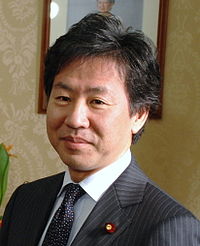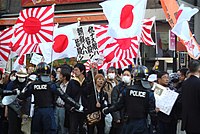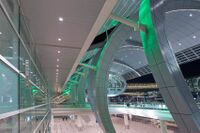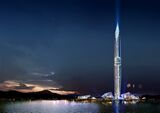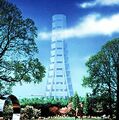Dayashina
The Republic of Dayashina | |
|---|---|
|
Flag | |
Anthem: "Hymn of the Bleeding Sun" | |
| Capital and largest city | Nakazara |
| Official languages | Dayashinese |
| Ethnic groups (2020) | 98% Dayashinese 2% other |
| Religion | No state religion |
| Demonym(s) | Dayashinese |
| Government | Parliamentary Constitutional Monarchy |
• Prime Minister | Daichi Noru |
• Emperor | Shogo Mazaki |
| Legislature | National Diet |
| Establishment | |
| 1936-1946 | |
| 1947 | |
| Population | |
• 2020 census | 100,700,000 |
| GDP (PPP) | 2018 estimate |
• Total | $5.22 trillion |
• Per capita | $51,867 |
| GDP (nominal) | 2020 estimate |
• Total | $4.78 trillion |
• Per capita | $47,468 |
| Gini (2018) | medium |
| HDI (2018) | very high |
| Currency | Dayashinese Yen (¥) |
| Date format | dd/mm/yyyy (AD) |
| Driving side | left |
| Calling code | +9 |
| Internet TLD | .da |
Dayashina is a nation in Septentrion.
History
Feudal Era
Yamazaki Shogunate (1615-1865)
Empire of Dayashina (1865-1946)
Modern Era
Geography
Political Geography
Landscape and climate
Biodiversity
Environmental issues
Politics
Government
Dayashina is a constitutional monarchy and parliamentary democracy in which the Emperor has very limited power. As a ceremonial figurehead, he is defined by the constitution to be "the symbol of the State and of the unity of the people". Executive power is wielded chiefly by the Prime Minister and his cabinet. Dayashina's system of government is largely based on the Anglian System, which is mostly attributed to the allied occupation of Dayashina after the Pan Septentrion War.
Dayashina's legislative body is the National Diet, seated in the nation's capital, Nakazara. The body is headed by a prime minister, who is the official head of government. Executive power is carried out by the prime minister and their cabinet, consisting most commonly of people chosen from the ranks of prime minister's party. Dayashina is divided into hundreds of consistuencies, each of which elects a member of parliament by plurality. General elections are called every five years.
The Dayashinese Conservative Party (DCP), Dayashinese Liberal-Democratic Party (DLDP), and Dayashinese Central Party (DCeP) have, in modern times, been Dayashina's top three political parties. The DLP managed to maintain control of the House up until the election of Genki Oda (DCP) in 1990, but held it again for another 25 years until the election of Daichi Noru (DCP) in 2010. Other parties of note include the Meng National Party, Rising Sun Party, and Classical Traditionalist Party.
Administrative divisions
Dayashina is divided into 14 prefectures, with one special prefecture in Sakurajima. Each prefecture has it's own governor, legislature, and administrative bureaucracy, and is further divided by cities and towns. In the case of Sakurajima, there exists a "provisional president" and a Septentrion League-led bureaucracy. The Republic of Dayashina has exclusive basing rights on the island, and is vying for the island to be repatriated into it's borders immediately following the official end of the Pan-Septentrion War war crimes trials.
Dayashina also maintains overseas territories which are incorporated into the system of the republic. Taga, Ryujima, Sora, Shogazu, and Aijuku are all fully dependent territories of the Republic of Dayashina and are governed under the Dayashinese administrative system. Dayashina also maintains one overseas dependency in Aozorajima, which retains it's own system of governance, but is represented in the National Diet, unlike Sakurajima.
Dayashina's capital and most populous prefecture is Nakazara, and is also noted as the largest city in the world by population and close to the largest in the world by landmass. It is part of the Central Belt and is the centre of a gradually forming megalopolis, linking together central Dayashinese cities, including Orajima, Nasai, Kojima, and Kanegawa. The Northern Belt consists of Daishi, Shizuna, Seto, Yokogato, and Masada. The Southern Belt includes Sakke, Omuri, Takena, and Izokara. Other smaller "belts" are popping up scattered across the landscape, but the Northern, Central, and Southern Belts are considered the "three cores" of Dayashina's population.
Foreign relations

Dayashina has diplomatic relations with most independent nations and has been a member of the Septentrion League since the 1950s. Dayashina is a member of the Trans-Hemithean Economics and Trade Organisation (THETA). The nation has extremely close relations with Tir Glas, having signed a number of mutual defence and economic agreements together. Additionally, Dayashina has operated as a critical gateway to Glasic contact with Menghe and has fostered excellent diplomatic relations between the three Helian states. Dayashina is a founding state of the Helian Ocean Prosperity Edict (HOPE), and Nakazara serves as a massive diplomatic hub for Hemithea, Vinya, and Meridia.
Dayashina also maintains close ties with Anglia. Following the defeat of the Imperial Dayashina in the Pan-Septentrion War, Dayashina has maintained close economic, cultural, and military ties with Anglia in a joint venture to protect shared values and interests. Dayashina and Anglia remain as one of the few friendly diplomatic links between Hemithea and Casaterra, and the two have partook the only instances of inter-alliance military cooperation since the Pan-Septentrion War (1991 Invasion of Kouraki, Operation Meridian Shield).
While Dayashina has been able to resolve all of it's territorial disputes with Menghe, tensions have most recently erupted with Maracaibo, with Dayashinese Prime Minister Daichi Noru and Maracaiban President George Robert Kerman constantly at a crossroads. Kerman has been known to spill anti-Dayashina rhetoric and serves to constantly remind the world of the crimes of Imperial Dayashina during the PSW, including the Genocide of Maracaibo. Noru has expressed interest in "quelling Maracaiban aggression in Meridia and elsewhere", which directly conflicts with the Maracaiban Meridian Doctrine. Noru was praised domestically for his actions in the Bakhriyan Civil War, which resulted in the repeal of the Meridian Doctrine
Dayashina is very cautious in it's mentioning of the Pan-Septentrion War, given the historical stigma associated with the exploits and crimes of the Empire during the time. Once spanning from Khalistan to Inishmore, countless people across that area, innocent and military, died as a result of the belligerent actions of the Empire. Various international parties, including Maracaibo, have criticised Prime Minister Noru for rekindling a negative view on Dayashina by the foreign audience, drawing equivalence between the contemporary opulence of the Dayashinese military and PSW-era nationalism. The Republic of Dayashina, following the end of the PSW, issued an official apology for "all war-crimes" during the war, but has yet to and likely will not issue an apology for entering the war, with non-partisan officials citing pre-war historical context.
Military
Dayashina maintains one of the largest military budgets of any country in the world. The country's military (Republic of Dayashina Defence Forces - RDDF), as reformed from remnants of the Imperial Dayashinese Armed Forces (IDAF) by the allies, is responsible for the defence of Dayashina and it's overseas territories. Additionally, it is arbitrarily responsible for the "maintenance of stability" in Meridia and partly the Helian Ocean. Reputed defence analysis surveys commonly rank Dayashina's military as one of the most powerful and technologically advanced in the world, boasting one of the world's largest navies by tonnage and one of the world's largest air forces.
The military is governed by the Ministry of Defence, and primarily consists of the Republic of Dayashina Army (RDA), the Republic of Dayashina Navy (RDN), and the Republic of Dayashina Air Force (RDAF). The RDDF is a regular participant in THETA exercises, and conducts an extensive amount of drills with Tir Glas and Menghe annually. The RDDF was first deployed in the Hanhae War of 1950, in which it reported general success in quelling the communist rebellion. More recently, the RDDF deployed independently to form a joint task force with Anglia during the Invasion of Kouraki (1991). Elements of the RDDF deployed to Kouraki once again in 2016 in response to the Takena Metro Bombings, in a successful operation to depose terrorist leaders in Kouraki. A massive RDDF contingent deployed into Vyzhva in 2019, where the first combat deployments of the Mosquito were undertaken by a joint Glaso-Dayashinese naval force. DSAS (Dayashinese Special Air Service) soldiers were involved in the Bakhriyan Civil War.

RDDF maintains a number of bases outside of the Dayashinese homeland. It operates bases in Hanhae, Sora, Shogazu, Aozorajima, Taga, FRNP, Shijuku. Additionally, it operates in numerous joint bases with the Tir Glas, Rajamaa, and other states across the world. The RDDF maintains about 415,000 total personnel, 307,000 of which are active and 108,000 of which are in reserve. Conscription is restricted in "peacetime", but the government retains the right to vote on whether to re-enact a system of conscription for the RDDF in wartime. Dayashina's defence budget spiked to $177.6 billion with the election of Daichi Noru, settling at 3.82% of the national GDP, which is the highest it has been since the Pan-Septentrion War. This rate of spending maintained for nearly a decade, until 2019, when the 2019 Defence Reforms forced a commitment to decrease military spending and redirect it to social spending. As of 2020, Dayashina spends 3.5% of it's GDP on the military.
Recent tensions with Maracaibo and other Casaterran states, as well as the re-election of Prime Minister Daichi Noru in 2015 have sparked the debate over the relation of the Dayashinese armed forces and Dayashinese society, and it's contributions to the revival of nationalism and radicalism in Dayashina.
Economy
| Share of world GDP (PPP) | |
|---|---|
| Year | Share |
| 1980 | 3.5% |
| 1990 | 4.1% |
| 2000 | 4.4% |
| 2010 | 4.8% |
| 2020 | 5.5% |
Dayashina is the fourth largest economy in the world, behind the Federated Fire Territories in terms of nominal GDP, and the fifth largest economy in the world in terms of purchasing power parity. It holds the world's second highest GDP per capita in terms of both nominal GDP and purchasing power parity. It is a developed, high-income, highly industrialised nation, with the services sector accounting for the majority of the country's gross domestic product. Dayashina is the home of several globally important corporations, with a strong emphasis in electronics and technological innovation.
With a stagnating population, Dayashina's labour force has shrunk slightly over the years, but still maintains a 49 million strong labour force in 2020, complemented by a low unemployment rate of 3.2%. As one of the most educated countries in the world, with its high rate of tertiary education completion, Dayashina benefits from a highly skilled work force. Dayashina's main exports are consumer electronics, transportation equipment, machinery, ships, and pharmaceuticals. Its main export partners are Menghe, Tír Glas, Hanhae, and Shijuku. It also retains significant economic ties with Ostland, Hallia, Tyran, and the Federated Fire Territories.
Dayashina rank among the top 10 nations in Septentrion in terms of ease of doing business, but it is generally accepted that it is held back in this regard by its unique and complex national brand of capitalism and work environment. Dayashina is a member of Trans-Hemithean Economics and Trade Association (THETA) and the Helian Ocean Prosperity Edict (HOPE).
The following is a list of the top 10 largest corporations by revenue in Dayashina.
| Rank | Name | Headquarters | Revenue (Mil $) |
Profit (Mil $) |
Industry |
|---|---|---|---|---|---|
| 1 | Takanami | Nakazara | 268,253 | 15,316 | Automotive |
| 2 | Dayacom | Nakazara | 207,624 | 32,934 | Electronics/Telecommunications |
| 3 | Masaoka Group | Takena | 141,832 | 6,721 | Conglomerate |
| 4 | Hoko | Daishi | 128,939 | 20,679 | Internet/Retail |
| 5 | Ibaraki | Nakazara | 113,432 | 12,094 | Electronics |
| 6 | Maya | Orajima | 105,954 | 1,289 | Financial |
| 7 | Nassan | Nakazara | 104,322 | 2,373 | Automotive |
| 8 | Lux | Daishi | 91,606 | 1,102 | Pharmaceuticals |
| 9 | Mitsuna | Nakazara | 83,342 | 3,459 | Conglomerate |
| 10 | Kawanami | Nakazara | 81,826 | 2,662 | Machinery |
Transportation infrastructure
Dayashina operates a highly technologically advanced transportation network, consisting of high-speed railways, a complex system of roads and highways, air routes, bus routes, and ferry routes.
By far the largest and most commonly used mode of transportation within the country is the high-speed rail network. As a world leader in high-speed rail development since it's conception, Dayashina encouraged continuous investment into the development and advancement of a high speed rail network. Maintained under the state-owned Imperial Rail Conglomerate, Dayashinese rail lines (mostly consisting of Shinkansen lines and several Maglev lines) connect to every major city in the country. IRC also maintains rapid-transport lines within major cities, connecting with the national network to form the second largest high-speed rail network in the world, second only to Menghe. The Dayashinese high-speed rail network connects to the Trans-Hemithean High Speed Railway, an initiative undertaken by 7 nations in THETA to form the largest high-speed rail network in the world, stretching from central Nukkumaa to southern Dayashina.
Bus routes and ferry routes are offered across the nation, mostly servicing for basic local transport and the connection of more isolated villages to the national rail network. Bus routes in Dayashina's largest cities are often used as a cheaper alternative to local rail transport to travel short distances. Ferry routes are critical in connecting cities that exist within Dayashina's megalopolises, and were actually fundamental to the development of such megaregions before the IRC developed underwater rail tunnels which now operate the same connections. They connect Nakazara with Orajima, Sakke and Omuri with Takena, and Daishi and Shizuna with Yokogato and Seto.
Aerospace is a major industry in Dayashina, and as such, Dayashina operates a massive and advanced air transport network. Dayashina operates three of Hemithea's largest airports in Makurazaki, Hokoya, and Oita, each of which bring in several dozens of millions of passengers each year, with Makurazaki consistently breaking 100 million passengers per year. Before the very recent development of the Trans-Hemithean High Speed Railway, air transport was unilaterally the most popular way in which people flew into Dayashina. Although air transport is still the most popular by some margin, the development of the TH-HSR is found to have caused a very minor but nevertheless steady decrease in passenger counts on Dayashina's national carrier.
Energy

As of 2020, 79% of Dayashina's energy was produce from nuclear power, 14% from hydropower, and and 7% from coal, natural gas, and petroleum. Due to its major investments and innovation in nuclear and hydroelectric power, Dayashina maintains one of the lowest carbon emission rates in the world. Such investments were part of a government initiative to domesticise Dayashina's energy production, and break dependence on imports of natural resources and mining materials from elsewhere, given it's comparatively small domestic reserve. As such, Dayashina developed one of the largest industries for nuclear power in the entire world, being a leading innovator in Generation III and IV reactor technology. Dayashina's nuclear network currently operates mostly on Generation II and Generation III reactors, operating both the largest nuclear power plant in the world and the first ABWR reactor in service. Dayashina is a world leader in research of Generation IV reactor technology, and is a contributor to the THETA fusion reactor experimentation programme.
Hydroelectric power is a growing industry within Dayashina, offered as a competing alternative to nuclear power, and is mainly generated through a network of dams along Dayashina's major rivers. By far the largest areas which see the implementation of hydropower are within the Divine Islands chain, with Aijuku being almost entirely powered by hydropower.
Dayashina has been repeatedly questioned on both the domestic and international stage in regards to it's massive investment into it's nuclear programme. Nations such as Fyrland and Maracaibo have questioned the nature of Dayashina's extensive nuclear network. Expert analysts project that Dayashina, like Tír Glas, could produce and operate nuclear weapons within mere months with it's current network. The Dayashinese government has repeatedly insisted that it's network is purely for civilian usage and that it will stay fully in compliance with the Septentrion Treaty on Atomic and Nuclear Disarmament. On top of that, Prime Minister Daichi Noru openly denounces the prospect of nuclear weapons development in Dayashina, stating that such weapons are "categorically in contrast to the morals guarded deeply by all Dayashinese people."
Services
Industry
Tourism
Science and technology
Consumer electronics
Aerospace
Robotics
Biotechnology
Cyber security
Demographics
Ethnic groups
Languages
Urbanisation
| Largest urban areas of Dayashina Dayashinese 2018 Census | |||||||||
|---|---|---|---|---|---|---|---|---|---|
| Rank | Urban area | Pop. | Principal settlement | Rank | Urban area | Pop. | Principal settlement | ||
 Nakazara |
1 | Nakazara | 38,452,000 | Nakaya | 11 | Kojima | 1,425,000 | Yokoya |  Orajima |
| 2 | Daishi | 11,115,000 | Kitaedo | 12 | Masada | 1,373,000 | Nishigawa | ||
| 3 | Orajima | 8,513,000 | Orajima | 13 | Tonomaru | 1,352,000 | Akayama | ||
| 4 | Takena | 6,524,000 | Honsho | 14 | Nogawa | 1,186,000 | Koruka | ||
| 5 | Kanegawa | 3,223,000 | Koruka | 15 | Sakke | 1,106,000 | Chomizu | ||
| 6 | Shizuna | 2,720,000 | Kitaedo | 16 | Omuri | 995,000 | Sakke | ||
| 7 | Matsuko | 1,921,000 | Kozaki | 17 | Seto | 892,000 | Sapporu | ||
| 8 | Saitama | 1,764,000 | Nishigawa | 18 | Yokogato | 805,000 | Kitaedo | ||
| 9 | Kawasaki | 1,701,000 | Fujiyama | 19 | Nakamori | 711,000 | Sapporu | ||
| 10 | Gokaido | 1,566,000 | Nezumizu | 20 | Yokona | 683,000 | Yokona | ||
Education
Health
Religion
Culture
Dayashinese culture, in its ancient origins, has evolved greatly since its conception. Contemporary Dayashinese culture combines traditional elements with influences from Tir Glas and Anglia. Traditional Dayashinese arts include various metalworks such as swords, and other hand crafts including textiles and ceramics. Various performances of dance and drama remain relevant in contemporary Dayashinese culture, as well as various staples of the old culture such as the martial arts. The Republic of Dayashina has enacted various systems for the protection and preservation of both tangible and intangible elements of the traditional culture, and contemporary developments have seen a sweeping resurgence in the interest in Dayashinese tradition, with particular focus on practices undertaken both within the Yamazaki Shogunate and Empire of Dayashina.
Architecture
Dayashina is well known for its variety of architectural styles, and its blending of traditional Dayashinese architectural aesthetics with dominant architectural movements in the modern day, such as neo-futurism. Traditional Dayashinese architecture is characterised by the widespread building of elevated wooden structures, most commonly with curved tile roofs. Traditionally made Dayashinese homes often incorporate fusuma. Fusuma remain to be an influential aspect of Dayashinese interior design, even into the modern age. During the 20th century, Dayashina was exposed to a variety of architectural styles from elsewhere, particularly from Casaterra and Vinya. Throughout the late 20th century and early 21st century, architecture in Dayashina has largely revolved around aesthetic futurism, functional modularity, electronic integration, and power efficiency. Modern Dayashinese exterior design is characterised by monolithic structures incorporating advanced hardening infrastructure for resistance against domestic climate and weather. Modern interior design in Dayashina is characterised for its continued use of fusuma-like room concepts, widespread electronic integration, and usage of LED light strips for power effiency.
Dayashina is home to three of the world's tallest buildings. Dayacom World Tower. standing at 1000 meters, has been the tallest skyscraper in the world since 2002. Shizuna World Financial Center. standing at 800 meters, is the third tallest building in the world, and provided the basis for the construction of the 828 meter Meridia Continental Commerce Center in Shijuku. The Grand Koizumi Resort and Convention Center is the 11th tallest building in the world, and is the largest building in the world owned by a single residential entity, at 512 meters tall.
Music
Dayashina has a thriving modern music industry, with a high level of domestic consumption and a rapidly emerging status as a musical exporter. Largely emulating the world-renowned Hanhae musical industry, Dayashinese artists are known for their wide usage of Anglian mixed in with their native language, Dayashinese, giving Dayashinese musical groups a greater appeal to the international audience. The usage of Anglian in Dayashinese music is widely attributed to the fact that all Dayashinese are mandatorily educated in the Anglian language throughout primary and secondary school. Dayashina is widely renowned for its diverse rap scene and culture, and maintains one of the largest rap music industries in the world, drawing many foreign rappers to perform in Dayashina as well. It is also home to several internationally known pop groups, emulating those of Hanhae.
Dayashina's modern musical industry drew heavily from that of Hanhae. Several Hanhae rappers and pop groups, who toured across Hemithea during the 2010s, are cited as critically influential in the emergence of similar groups in Dayashina and their explosion onto the international market. Dayashinese rap collective Reload credits Hanhae rapper Crazy Ape as their main inspiration, along with various acts from Meridia signed to Dayashinese labels. The pattern of foreign inspiration is common among Dayashina's most popular musical artists, and is most prolifically exaggerated among Dayashinese pop groups, who are often trained and recruited by Hanhae musical agencies.
Electronic music is also an extremely popular musical genre in Dayashina. Dayashina is widely regarded as the world's capital for electronic music, pioneering genres such as dubstep, trap, progressive house, future house, and witch house. Dayashinese electronic music producers are internationally renowned for their individual works and are regularly contracted by international artists and labels to produce beats for popular vocalists. 2020 marked the beginning of the witch house era of Dayashinese electronic music, with a number of witch house producers taking front-running positions on Dayashinese music charts, though other electronic genres continue to be released and retain chart positions.

